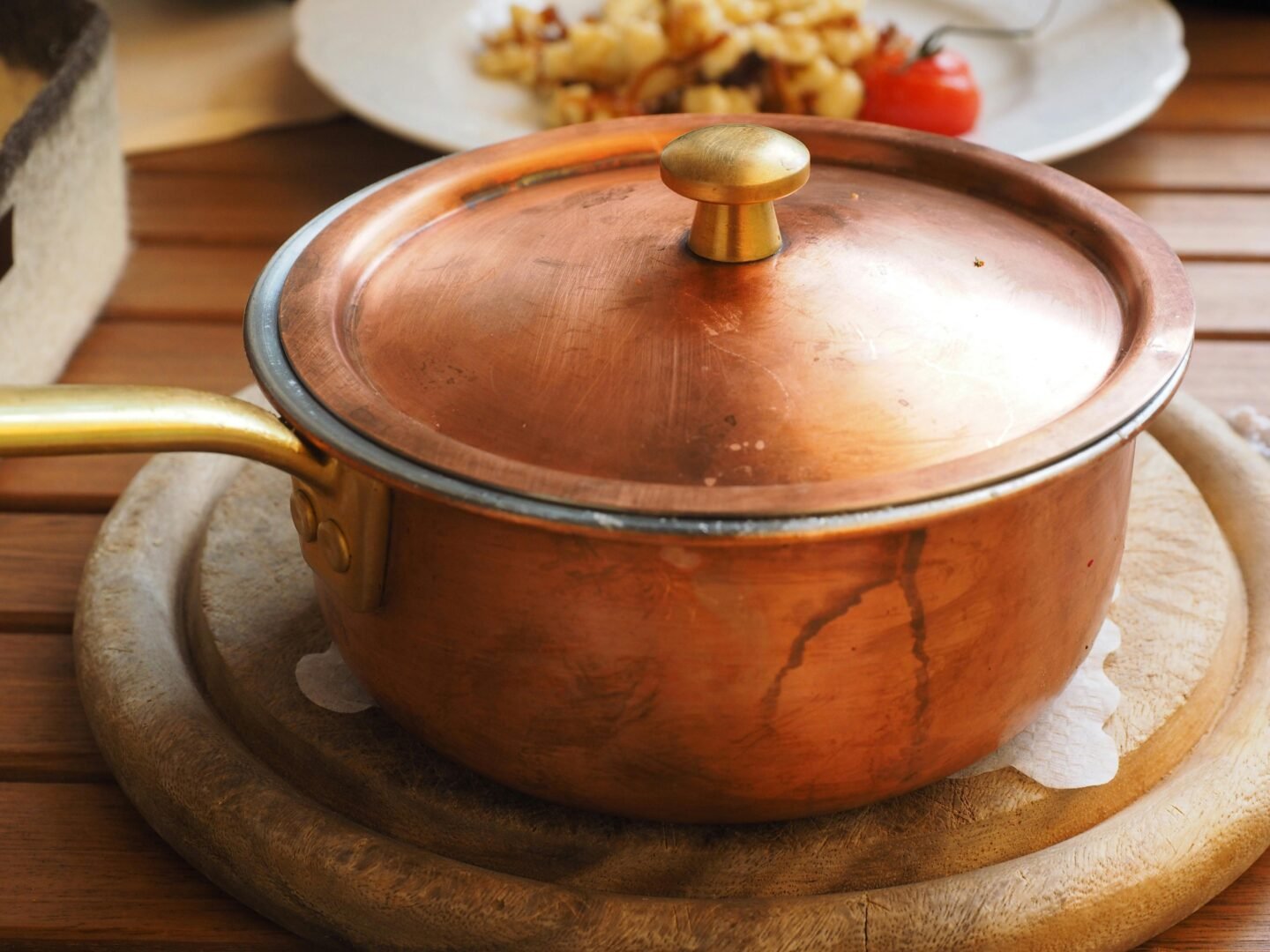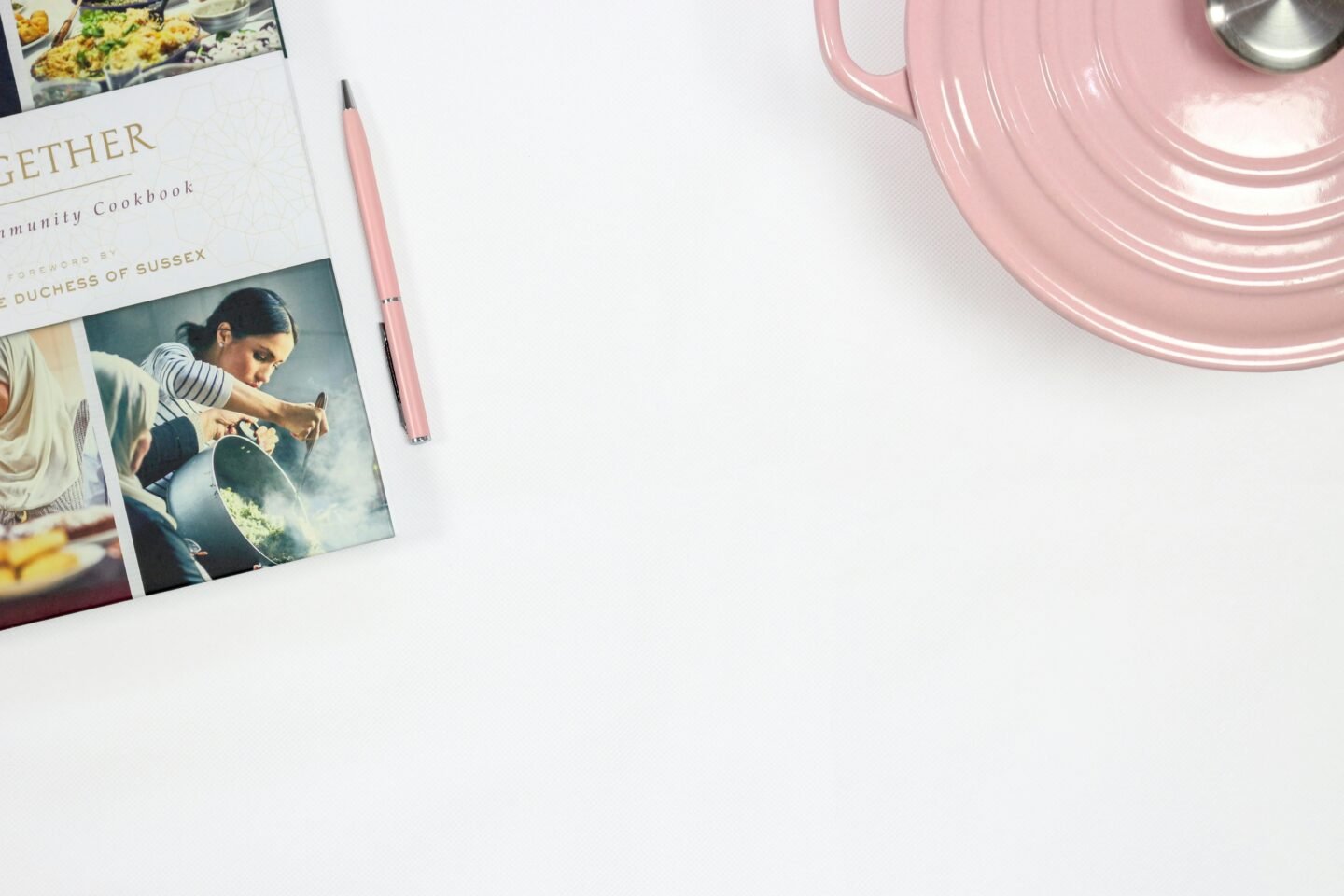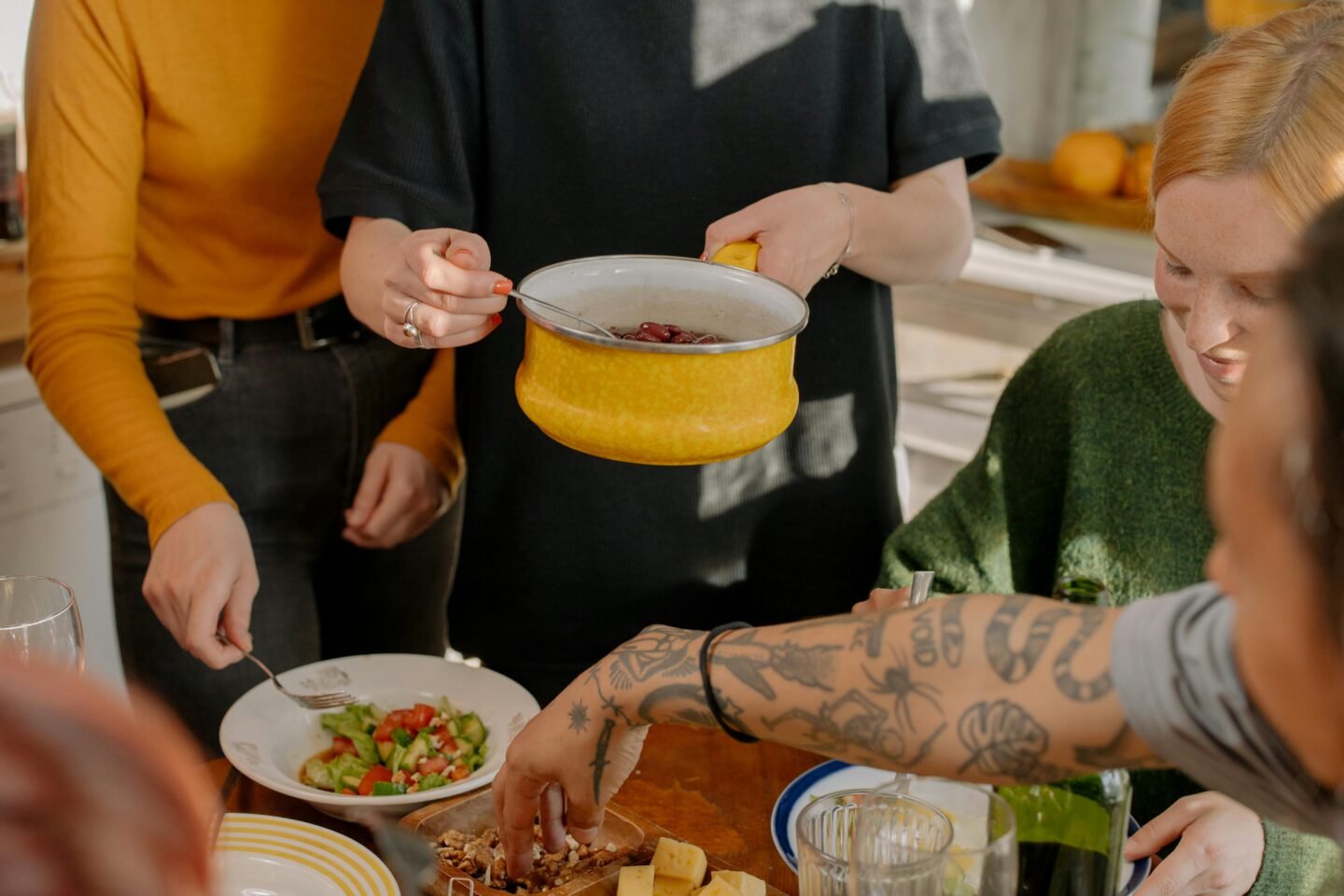Hey sweet friends,
Can we have an honest conversation about something that’s been weighing on my heart? As moms, we spend so much time thinking about what we feed our families – buying organic produce, reading ingredient labels, avoiding processed foods. But have we thought about what we’re cooking that healthy food in?
I’ll be honest – I used to think all cookware was basically the same. A pan was a pan, right? Then I started learning about “forever chemicals” and toxic coatings that can leach into our food, and I realized I needed to do some serious research for my family’s sake.
The world of non-toxic cookware can feel overwhelming at first, with all the acronyms (PFAS, PFOA, PTFE – what does it all mean?), conflicting information, and price tags that can make you gulp. But I’ve done the digging, tested some options, and I’m here to break it all down in a way that makes sense for real families with real budgets.
Let’s talk about how to choose cookware that keeps your family safe without making you feel like you need a chemistry degree to cook dinner.
What Are We Actually Avoiding? The Toxic Chemical Breakdown
Before we dive into what to buy, let’s understand what we’re trying to avoid. The main culprits are PFAS (per- and polyfluoroalkyl substances), often called “forever chemicals” because they don’t break down easily and can stay in the environment and in the human body for a long time.
PFOA (Perfluorooctanoic Acid): The International Agency for Research on Cancer classifies PFOA, a heavily used and well-studied PFAS chemical, as a possible carcinogen. Since 2006, certain known toxins found in Teflon including two types of PFAS have been phased out of the Teflon manufacturing process: PFOA and PFOS. The good news is that PFOA has been largely phased out, but it can still be found in older cookware.
PTFE (Polytetrafluoroethylene): PTFE is safe and non-toxic at low temperatures, but begins to break down into toxic PFAS chemicals around 392F, and begins to give off dangerous fumes around 500F. These fumes cause flu-like symptoms in humans and are lethal to birds.
The Bottom Line: Even products made without PFOA may contain the compound because of how they’re manufactured, and most products with PFOA-free labels actually contain PTFE and therefore put you at risk of PFAS exposure.
Here’s what really got my attention: If you own nonstick cookware that pre-dates 2006, you may want to seriously consider replacing it. I checked my cabinets and realized some of my “trusty” pans were definitely older than that!

The Safest Materials: Your Non-Toxic Options
After researching extensively, here are the materials that experts consistently recommend as the safest:
1. Stainless Steel – The Reliable Workhorse
Stainless steel is generally considered one of the safest and most durable options when selecting nontoxic cookware, and I can personally vouch for this. I’ve been using stainless steel for about two years now, and while there was a learning curve, it’s become my go-to for most cooking.
Pros:
- Completely non-reactive and safe
- Lasts literally forever with proper care
- Works on all cooktops including induction
- Dishwasher safe
- You can use metal utensils
Cons:
- Requires some technique to prevent sticking
- Not naturally non-stick
- Can be pricey upfront (but it’s a lifetime investment)
Best Brands: 360 Cookware is our top pick for non-toxic stainless steel cookware. It’s an 18/8 blend, made in the USA, and lasts forEVER. Tramontina won out. This 10-piece set is a good option for most home cooks, offering two frying pans, two sauce pans with lids, a 3-quart braiser with a lid and a 6-quart pot with a lid.
2. Cast Iron – The Time-Tested Champion
Lodge has been crafting heirloom-quality cast iron cookware in South Pittsburg, Tennessee since 1896, making it one of the most trusted names in American kitchens. Every piece is made from just iron and vegetable oil, so it’s naturally non-toxic — no synthetic coatings, no PFAS, PFOA, PTFE, or any harmful chemicals.
Pros:
- Naturally non-toxic – just iron and oil
- Gets better with age and use
- Incredible heat retention
- Works on stovetop, oven, grill, even campfire
- Very affordable
Cons:
- Heavy
- Requires seasoning and special care
- Can rust if not properly maintained
- Not great for acidic foods
My Experience: I love my Lodge cast iron skillet for searing steaks and making cornbread. Each pan comes pre-seasoned with 100% natural vegetable oil, giving it a natural, easy-release finish that improves with every use.
3. Enameled Cast Iron – The Best of Both Worlds
Enameled cast iron lovers rejoice: This is the ultimate pairing for all of your favorite things about cast iron without any of the fussy care of re-seasoning. In fact, you can pop these babies in the dishwasher!
Pros:
- All the benefits of cast iron without the maintenance
- Naturally non-stick surface
- Beautiful enough to serve from
- No seasoning required
- Easy cleanup
Cons:
- More expensive than regular cast iron
- The enamel can chip if dropped
Best Brands: Le Creuset is the gold standard, but Great Jones meets all CA Prop 65 standards… We like their enameled cast iron as a more affordable alternative to Le Creuset. I was so excited when I heard that Caraway was coming out with an enameled cast iron collection!
4. Pure Ceramic – The Purist’s Choice
Pure ceramic is the most non toxic cookware material. Specifically, the Xtrema brand is 100% ceramic from the glaze to the core. That means that the material you are cooking with is inert – it won’t react with the food you are cooking and it won’t leach any unwanted chemicals into your food.
Pros:
- Absolutely no chemicals or metals
- Microwave and oven safe
- Completely inert and non-reactive
- Beautiful presentation
Cons:
- Can be fragile
- Limited heat conductivity
- More expensive
- Takes practice to use effectively
5. Ceramic-Coated Cookware – The Non-Stick Alternative
Ceramic coating is the safest non-stick alternative to traditional Teflon coatings, which may contain PFAS. This has been my transition cookware as I moved away from traditional non-stick.
Pros:
- PFAS-free non-stick surface
- Easy to clean
- Lighter than cast iron
- Good for beginners
Cons:
- Coating can wear off over time
- Not as durable as other options
- Can’t use metal utensils
Best Brands: This nonstick pan from Caraway is impressive. In our tests, the surface heated evenly, so there were no hot spots, and fried eggs easily slid out one after another. The handle is super-sturdy and stays cool to the touch as you cook. GreenPan Valencia Pro Hard Anodized 11-Piece Cookware Pots and Pans Set. This set comes fully loaded with three fry pans, two sauce pans with lids, a large sauté pan with a lid and a good-sized 5-quart stockpot with a lid.
What to Look For When Shopping
Reading Labels Like a Pro
Because CR’s tests and research show that even products made without PFOA may contain the compound because of how they’re manufactured, we have decided to no longer display “PFOA-free” in our ratings of nonstick cookware. Here’s what to actually look for:
Good Signs:
- “PTFE-free” certification
- “PFAS-free” testing results
- Third-party safety certifications
- Clear material descriptions (100% stainless steel, pure ceramic, etc.)
Red Flags:
- “PFOA-free” only (doesn’t mean PFAS-free)
- Vague “non-stick coating” descriptions
- Proprietary coating names without disclosure
- No safety certifications

Budget-Friendly Starting Points
I know not everyone can replace their entire cookware collection at once. Here’s how to prioritize:
Start with these pieces:
- One good stainless steel or cast iron skillet
- A stainless steel saucepan
- A larger pot for pasta/soups
Total budget for basics: $100-200 can get you started with quality pieces that will last years.
At less than $40, it’s an enticing alternative to our top-rated Butter Pat Joan Cast Iron pan ($345). Lodge cast iron is incredibly affordable and will last generations.
Transitioning Away from Non-Stick: My Personal Journey
I’ll be honest – switching from non-stick cookware wasn’t instant magic. There was definitely a learning curve, and I had a few dinners where things stuck more than I’d like. But here are the techniques that made all the difference:
For Stainless Steel:
- Preheat the pan properly (medium heat for 2-3 minutes)
- Test with a drop of water – it should sizzle and roll around
- Use adequate fat (oil or butter)
- Don’t move food too quickly – let it develop a crust
For Cast Iron:
- Start with fatty foods like bacon to build up seasoning
- Heat gradually and evenly
- Clean while still warm with hot water and a stiff brush
- Dry completely and add a thin layer of oil
The Game-Changer: Understanding that some sticking is normal and doesn’t mean you’re doing it wrong. A stainless steel pan isn’t supposed to be as non-stick as Teflon – and that’s actually a feature, not a bug, because it creates better browning and flavor.

Taking Care of Your Investment
One of the best things about toxin-free cookware is that it’s built to last. Here’s how to make sure it does:
Stainless Steel:
- Use Bar Keepers Friend for any discoloration
- Avoid harsh abrasives on the exterior
- Let it cool before washing to prevent warping
Cast Iron:
- Dry thoroughly after washing
- Apply a thin layer of oil while still warm
- Store in a dry place
- Re-season as needed
Ceramic-Coated:
- Hand wash when possible
- Use wooden or silicone utensils only
- Avoid temperature shocks (don’t put a hot pan in cold water)
The Real-Life Mom Test
After using various non-toxic cookware options for the past year, here’s my honest assessment:
What Actually Works:
- My stainless steel skillet for searing chicken and vegetables
- Cast iron for anything that needs high heat or oven finishing
- Ceramic-coated pan for eggs and delicate foods
What I Learned:
- You don’t need a huge collection – a few quality pieces work better than lots of mediocre ones
- The learning curve is real but short – about 2-3 weeks to feel comfortable
- The peace of mind is worth the initial adjustment
Unexpected Benefits:
- Food tastes better (seriously!)
- I’m more engaged with cooking because I can’t just set it and forget it
- My kids are learning proper cooking techniques
Common Concerns and Real Talk
“It’s too expensive.” Yes, quality cookware costs more upfront. But when you break it down per use over years, it’s actually more economical. My $200 stainless steel set will last decades, while I was replacing $50 non-stick pans every 2-3 years.
“I don’t have time to learn new techniques.” I thought this too! But honestly, it took about two weeks of regular cooking to feel comfortable. Start with one piece and gradually build your skills.
“My family will revolt if eggs stick.” The nonstick coating is ceramic (made without PTFE) and stood up well in our durability test. Ceramic-coated pans can be a great transition option for egg cooking while you’re learning other techniques.
“What about my bird?” These fumes cause flu-like symptoms in humans and are lethal to birds. If you have pet birds, avoiding PTFE cookware entirely is absolutely essential for their safety.
Making the Switch: A Step-by-Step Plan
Month 1: Replace your most-used skillet with stainless steel or ceramic-coated option Month 2: Add a cast iron pan for high-heat cooking Month 3: Replace your main saucepan Month 4: Evaluate what else you actually use regularly
Don’t feel pressure to throw everything out at once. It’s also worth noting that any nonstick cookware sporting scratches from years of use should be replaced immediately. Focus on replacing damaged pieces first, then gradually upgrade the rest.
The Bottom Line for Our Families
Here’s what it comes down to for me: We work so hard to feed our families well – choosing organic ingredients, avoiding processed foods, reading labels carefully. Using cookware that might be leaching chemicals into that healthy food just doesn’t make sense.
The transition to toxin-free cookware isn’t always easy, and it does require some learning and investment. But knowing that I’m not introducing unknown chemicals into my family’s food gives me such peace of mind.
My Top Recommendations for Getting Started:
- Best overall value: Tramontina stainless steel set
- Best single pan upgrade: Lodge cast iron skillet
- Best for non-stick lovers: Caraway ceramic-coated set
- Best investment piece: Le Creuset or Great Jones enameled cast iron
Remember, sweet friend, you don’t have to be perfect. You don’t have to replace everything at once. Just start somewhere, and know that every small step toward safer cooking is protecting your family’s health.
What questions do you have about making the switch? I’d love to help you navigate this journey – we’re all figuring it out together, one healthy meal at a time.
Here’s to cooking with confidence and peace of mind, Mish
P.S. If you decide to upgrade your cookware, consider donating your old non-stick pieces to a local shelter or charity – just make sure they’re not scratched or damaged first.